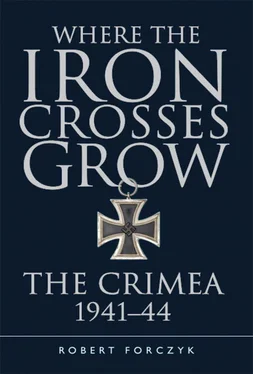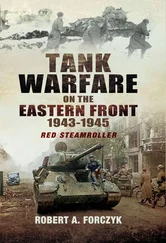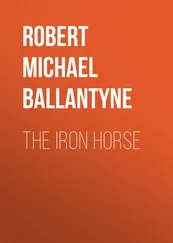The Stavka was incensed that Kuznetsov had lost the Tatar Wall line so quickly, and ordered him to keep attacking. At dawn on September 27, Batov renewed his counterattack to push the Germans back to the Tatar Wall. Initially, Batov’s infantry retook most of Armyansk, and Hitzfeld’s troops retreated to a strongpoint at the brick factory in the northern part of the town. There he held on against Batov’s infantry attacks all day long. However, German pioneers from Pionier-Bataillon 173 began building a wooden 16-ton bridge across the western end of the Tatar Ditch, which enabled them to get some StuG III assault guns from Oberleutnant Reinhard Näther’s 3./Sturmgeschütz-Abteilung 190 across. Soviet artillery fire caused great losses among the laboring pioneers, and Pionier-Bataillon 173 suffered 118 casualties in creating the crossing over the Tatar Ditch. [7] la, Anlagen z. KTB 7, Band 3. Bericht über den Einsatz des Pionier-Bataillons 173 beim Angriff auf die Landenge von Perekop in der zeit vom 24. – 28.9.41, September 9 – October 4, 1941, 73. Infanterie-Division, NAM (National Archives Microfilm), series T-315, Roll 1064.
A sharp German attack by a Kampfgruppe from 50. Infanterie-Division, supported by the assault guns and some Stukas from StG 77 retook most of Armyansk and pushed Batov’s depleted infantry back.
In one final fling, Batov attacked Armyansk again at dawn on September 28, and not only drove out Hitzfeld’s troops, but some of Major Baranov’s T-34 tanks even succeeded in reaching the Tatar Wall. Yet the victory was brief, and Batov’s last reserves were spent in the process. By 1835hrs, Kuznetsov reported to Moscow that he had no reserves left and his hold on Armyansk was tenuous. Less than three hours later, the Germans recaptured Armyansk and Kuznetsov pleaded for permission to withdraw to his reserve positions at Ishun, which were unoccupied. The Stavka was very displeased with Kuznetsov and believed – probably rightly so – that he had exercised poor use of his reserves and was unable to coordinate effective counterattacks. Yet the Stavka finally acceded and authorized Kuznetsov to withdraw to Ishun. Over the next few days, Major Baranov’s tankers fought a series of successful rearguard actions that prevented an effective pursuit, and all but one of his ten T-34s came through intact.
The battle of Perekop cost Hansen’s LIV Armeekorps a total of 2,641 casualties, and both of his two divisions were badly mauled after five days of see-saw combat. Hitzfeld’s IR 213 had suffered a total of 746 casualties, including two battalion commanders, eight company commanders, and 49 platoon leaders. [8] la, Anlagen z. KTB 7, Band 3. Gefechtsbericht über den Angriff des Regiments auf die Landenge von Juschunj , Infanterie-Regiment 213, September 9 – October 4, 1941, 73. Infanterie-Division, NAM (National Archives Microfilm), series T-315, Roll 1064.
German material losses were also quite heavy. The 73. Infanterie-Division lost 13 artillery pieces and 12 3.7cm Pak guns, along with a good deal of infantry equipment. However, it was the loss of trained combat leaders, particularly the death of five battalion commanders, that was so painful. On the other side of the ledger, the Germans claimed to have captured 10,019 troops from the 51st Army at Perekop, along with 32 tanks, 68 artillery pieces (incl. 7 150mm howitzers), 43 Pak guns, and 88 mortars – indicating that the 156th and 271st Rifle Divisions were almost totally destroyed. [9] Ic, Tätigkeitsbericht, July 17 – November 16, 1941, 73. Infanterie-Division, NAM (National Archives Microfilm), series T-315, Roll 1065.
Nevertheless, it is clear that the battle of Perekop was a close-run thing and that the German margin of victory was very slim.
Hansen might have made short work of the Ishun position if the Soviet Southern Front had not recovered and launched a painful counterattack against the Romanians west of Melitopol. In order to feed the fight at Perekop, Manstein had stripped XXX Armeekorps of many of its best resources and pushed Romanian units into the front line, which the Soviets decided to exploit. Just as the Tatar Wall was breached, Manstein was compelled to send the LSSAH, all of Sturmgeschütz-Abteilung 190, and much of his Fliegerkorps IV air support to deal with the crisis near Melitopol. The resulting battle of the Sea of Azov lasted more than a week, resulting in the encirclement and destruction of the Soviet 9th and 18th Armies, but the 51st Army received a vital reprieve.
____________
After Hansen’s breakthrough at Perekop, Kuznetsov and Oktyabrsky reported to Moscow that they would have difficulty holding the Crimea without reinforcements and recommended evacuating Odessa, transferring the Independent Coastal Army by sea to reinforce the 51st Army in the Crimea. Reluctantly, the Stavka agreed to this recommendation on September 29, 1941, and four days later the 157th Rifle Division began moving from Odessa to Sevastopol, escorted by the Black Sea Fleet. [10] Stavka Directive No. 002454, 29 September 1941, TsAMO, F. 148a, Op. 3763, D. 96, L. 52, 53.
Distracted by the fighting around Melitopol, Fliegerkorps IV made no effort to interfere with the evacuation of Odessa. Quietly, the Black Sea Fleet picked up the pace in the second week of October, and it was not until the final convoy began loading at Odessa on October 14 that the Luftwaffe took an interest in the Soviet operation. Yet of the 11 Soviet transports, loaded with thousands of troops, the Luftwaffe managed to sink only one small transport and damage another. The bulk of the Independent Coastal Army was delivered virtually intact to Sevastopol – this was perhaps the Black Sea Fleet’s finest moment in World War II.
Kuznetsov would need all the soldiers he could get to hold the position at Ishun. Although the 51st Army still had about 50,000 troops in the Crimea, he had to leave one rifle division to guard the Chongar Peninsula and other troops to watch possible crossing sites across the Sivash, leaving barely 15,000–20,000 troops to form a line at Ishun. Furthermore, many of his remaining troops were militiamen, and the cream of Batov’s 9th Rifle Corps had been eliminated in the fighting for Perekop. Oktyabrsky sent Kuznetsov two battalions of naval infantrymen from Sevastopol to reinforce the Ishun position, and the 157th Rifle Division that was the first to arrive from Odessa was en route, but Kuznetsov was short of artillery as well. The Stavka did send aerial reinforcements to the Crimea, including a squadron of the latest Yak-1 fighters for the 32nd Fighter Regiment (32 IAP) of the VVS-ChF, leading to several sharp encounters with the Bf-109s of III./JG 77.
German scouts arrived near Ishun, following in the footsteps of Kuznetsov’s retreating army; they found it to be nearly as formidable as the Perekop position. Ishun was a small town at the southern base of the Perekop Peninsula, flanked by three large salt lakes and the Black Sea. Only three mobility corridors existed between these obstacles, and the widest, between the Black Sea and Lake Staroe, where the rail line ran, was only 1,400 yards wide. The terrain was completely devoid of cover and was marshy, making movement of assault guns or other heavy weapons very difficult. Kuznetsov deployed his steadiest units, the 361st Rifle Regiment, a rifle battalion from the 172nd Rifle Division, and the two naval infantry battalions to guard this critical sector. He put the rest of the veteran 156th Rifle Division in the other potential avenue of advance between Lake Staroe and Lake Krasnoe, with a strongpoint built in a bromide factory. In order to cover his right flank, Kuznetsov deployed his 106th and 271st Rifle Divisions between Lake Krasnoe and the Sivash, even though it was a less likely avenue of approach. Indeed, throughout the fighting on the Perekop Isthmus, Kuznetsov consistently put too many forces to cover his flank on the Sivash even though Manstein had found this option impractical – the memory of the 1920 campaign now created a fear in the Red Army of being flanked. In terms of support weapons, Major Baranov still had nine T-34 tanks operational in the 5th Tank Regiment, but Kuznetsov’s artillery park was much reduced and limited to mostly older 76mm howitzers. Several improvised armored trains were being hastily assembled in Sevastopol’s workshops and the Voykovets would soon be joined by the Smyert’ fashizmu (Death to Fascism), which would provide Kuznetsov with some useful mobile firepower.
Читать дальше












